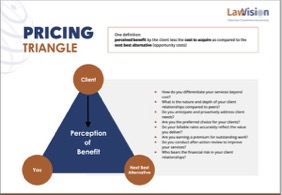In The Hitchhiker’s Guide to the Galaxy, a race of hyper-intelligent beings builds a computer to discover the ultimate answer to life, the universe, and everything. After seven and a half million years, the machine reveals the answer: 42.
Unfortunately, no one knows what the actual Question is. Even worse, the second computer—Earth—designed to discover the Question, was destroyed to make way for a hyperspace bypass before it could complete its program. As a result, the actual Question to the Ultimate Answer was never revealed.
Right now, many in the legal world are asking a similarly misdirected question:
“Will AI bring down law firm rates?”
According to a recent Law.com (link) article and the Thomson Reuters 2025 Generative AI in Professional Services Report (link), most lawyers don’t expect it to change. But perhaps that’s the wrong question altogether.
Rates Are Still Set by Markets, Not Machines
Rates don’t live in code—they live in the marketplace. Broader, more resilient forces shape them, including:
- Demand for legal expertise
- Client expectations and procurement leverage
- Competitive positioning and firm differentiation
- Economic cycles and resource constraints
Whether a memo is drafted by a junior associate or a generative AI tool, the rate a client is willing to pay hinges on perceived value, not on time or technology. That is where the LawVision Pricing Triangle comes in—a framework for uncovering fair value at the intersection of:
- The client’s perception of benefit
- The cost to acquire that benefit (your price)
- The next best alternative

Generative AI might reshape workflows, but it doesn’t change how clients buy confidence, outcomes, and expertise, not tools.
AI Hasn’t Delivered Transforming Productivity Gains Yet —But That’s Changing
In our 2024 Strategic Pricing Flash Survey, nearly 100% of respondents reported no material productivity gains from AI over the past two years. And yet, many expect that to change in 2025.
(Interested in taking part in the 2025 Survey? Click this Link)
Why? Because law firms are transitioning from experimentation to execution. A quarter of survey respondents plan to introduce new pricing approaches this year as AI capabilities become more embedded.
The growing adoption of AFAs marks a decisive shift from speculative buzz to disciplined opportunity. Front-line lawyers and pricing leaders—those who best understand client expectations and value—must convert that momentum into precise fees, scope, and performance strategies.
The Criticality of Today’s Rate Environment
Rate growth through Q1 has remained strong, continuing a multi-year trend of upward movement. But behind the numbers lies a more fragile reality: the broader economy is growing more volatile, and the legal economy shows signs of uncertainty. That is why getting your pricing strategy—right now—may be more critical than ever. In this environment, pricing is not just a finance or operations decision. It is a strategic one. Firms that align rate structures with market realities, client tolerance, and perceived value will be best positioned to sustain momentum regardless of what the economy brings next.
The Real Opportunity Is Not Lower Rates — It is Better Pricing
Rather than asking whether AI will reduce rates, a better question is:
Can firms use AI to effectively discover, deliver, and price legal value?
According to the 2025 GenAI Report, 40% of professionals expect AI adoption to accelerate using alternative fee arrangements. But this is not about discounting—it is about pricing differently:
- Outcome-based pricing models
- Tiered service delivery frameworks
- Bundled solutions that pair AI efficiency with strategic legal insight
However, firms must navigate the ethical and regulatory guardrails that define our profession when pursuing new pricing strategies. The ABA’s Formal Opinion 512 reinforces that lawyers remain responsible for oversight, confidentiality, and competence, regardless of how much AI is involved. The same holds for pricing: fees must remain reasonable, transparent, and aligned with ethical duties.
That said, regulation will evolve, just as it has with outsourcing, cloud platforms, and other innovations. Forward-looking firms can lead with integrity, crafting pricing approaches that enhance client value and professional sustainability.
In Summary
Asking whether AI will reduce law firm rates is akin to asking Deep Thought about the meaning of life. You may get an answer, but it won’t necessarily move you forward.
Rates aren’t determined by the tools used to deliver the work—they are influenced by market dynamics, client trust, and the firm’s capability to articulate its value. AI won’t redefine pricing on its own. However, it can be a powerful lever for firms that understand how to utilize it.
💡 If you are thinking about how AI and pricing strategy intersect, help shape the conversation by participating in our 2025 Strategic Pricing Flash Survey.
Posted In
